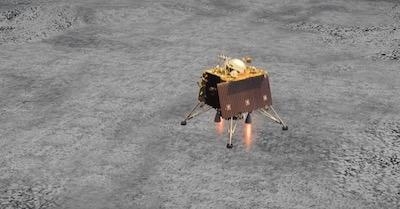Tue, Sep 10, 2019
Contact With The Spacecraft Had Been Lost During Its Final Descent
After losing contact with the Chandrayaan 2 Vikram lunar lander during its final descent to the moon's surface, the Indian Space Agency says it has located the spacecraft on the surface of the moon, though they have few details about the condition of the lander.

NPR reports that contact with the lander was lost about 2:00 a.m. Indian local time Saturday when the lander was about 1.3 miles above the lunar surface. The lander had successfully separated from its orbiter and was headed towards its landing site near the moon's south pole when contact was lost.
About 36 hours later, K. Sivan, the head of India's space agency, told the Indian news agency ANI that the orbiter had captured a thermal image of the Vikram lander on the lunar surface. He said that the agency is trying to reestablish contact with the lander.
The lander carried a rover that was intended to document the presence of ice deposits around the moon's south pole. The ice was discovered by a previous Indian mission to orbit the moon.
India was attempting to become the 4th nation to land a spacecraft on the moon's surface, and many in the country have declared the mission to be a success even though the Indian space agency has not confirmed those claims. The Indian Space Research Organization said in a statement posted on its website that "The Vikram Lander followed the planned descent trajectory from its orbit of 35 km to just below 2 km above the surface. All the systems and sensors of the Lander functioned excellently until this point and proved many new technologies such as variable thrust propulsion technology used in the Lander. The success criteria was defined for each and every phase of the mission and till date 90 to 95% of the mission objectives have been accomplished and will continue contribute to Lunar science, notwithstanding the loss of communication with the Lander."
India Today reports that the lander is in one piece, lying "in a tilted position" on the lunar surface "after a hard landing".
(Image from ISRO animation video)
More News
Pilot Applied Full Aft Stick And Nose-Up Trim, But The Airplane Remained On The Runway Analysis: The pilot reported that a preflight inspection and flight control checks revealed n>[...]
A Few Questions AND Answers To Help You Get MORE Out of ANN! 1) I forgot my password. How do I find it? 1) Easy... click here and give us your e-mail address--we'll send it to you >[...]
From 2022 (YouTube Edition): Before They’re All Gone... Humankind has been messing about in airplanes for almost 120-years. In that time, thousands of aircraft representing i>[...]
Advanced Air Mobility (AAM) A transportation system that transports people and property by air between two points in the NAS using aircraft with advanced technologies, including el>[...]
Aero Linx: MQ-1B Predator The MQ-1B Predator is an armed, multi-mission, medium-altitude, long-endurance remotely piloted aircraft that is employed primarily as an intelligence-col>[...]
 NTSB Final Report: Douglas A-4K
NTSB Final Report: Douglas A-4K ANN FAQ: Q&A 101
ANN FAQ: Q&A 101 Classic Aero-TV: PBY Catalina--From Wartime to Double Sunrise to the Long Sunset
Classic Aero-TV: PBY Catalina--From Wartime to Double Sunrise to the Long Sunset ANN's Daily Aero-Term (07.01.25): Advanced Air Mobility (AAM)
ANN's Daily Aero-Term (07.01.25): Advanced Air Mobility (AAM) ANN's Daily Aero-Linx (07.01.25)
ANN's Daily Aero-Linx (07.01.25)



